Proposed Night-time Flying Policy | Aircraft Night Noise Assessment Report | Maps | Night Noise Contours INM Assumptions | 1 Manston Airport night noise assessment review | 2 Review of Night Quota Schemes at other UK Airports | 3 GLOSSARY OF TERMS
September 2010
Bickerdike Allen Partners
BAP Report Ref. A9293-R01-PH
MANSTON AIRPORT
Aircraft Night Noise Assessment Report
September 2010
Bickerdike Allen Partners
Acoustic Consultants
121 Salusbury Road
London, NW6 6RG
Tel: +44 (0) 20-7625 4411
Fax: +44 (0) 20-7625 0250
E-mail: mail@bickerdikeallen.com
www.bickerdikeallen.com
CONTENTS
1.0 INTRODUCTION
2.0 SITE DESCRIPTION
3.0 aircraft movements at night
3.1 Current Night-time Aircraft Movements
3.2 Future Night-time Aircraft Movements
4.0 NIGHT NOISE ASSESSMENT CRITERIA
5.0 Noise contour AND ASSESSMENT METHODOLOGY
5.1 General
6.0 IMPACT OF NIGHT-TIME AIRBORNE AIRCRAFT NOISE
6.1 Current Night Operations
6.2 Future Night Operations -2018
FIGURES
Figure 1 Approach, Departure and Circuit Routes
Figure 2.1 2009 Night-time Noise Contours LAeq,8h
Figure 2.2 2018 Predicted Night-time Noise Contours LAeq,8h
Figure 3.1 Boeing 737-800 85, 90, 95 dB(A) SEL Noise Footprints, Approach Runway 28
Figure 3.2 Boeing 737-800 85, 90, 95 dB(A) SEL Noise Footprints, Departure Runway 28
Figure 4.1 Boeing 747-400 85, 90, 95 dB(A) SEL Noise Footprints, Approach Runway 28
Figure 4.2 Boeing 747-400 85, 90, 95 dB(A) SEL Noise Footprints, Departure Runway 28
Figure 4.3 Boeing 747-400 85, 90, 95 dB(A) SEL Noise Footprints, Approach Runway 10
Figure 4.4 Boeing 747-400 85, 90, 95 dB(A) SEL Noise Footprints, Departure Runway 10
Figure 5.1 McDonnell Douglas MD-11 85, 90, 95 dB(A) SEL Noise Footprints, Approach
Runway 28
Figure 5.2 McDonnell Douglas MD-11 85, 90, 95 dB(A) SEL Noise Footprints, Departure
Runway 28
APPENDICES
Appendix A Assumptions used in the derivation of Noise Contours and SEL Footprints
INTRODUCTION
Manston Airport (MSE) is seeking to agree a policy with Thanet District Council to establish a regular
schedule of flights into and out of the airport that will occur between the recognised night-time hours
of 23.00 and 07.00. It is already acknowledged and accepted that in order for an airport like MSE to
function successfully, a degree of flexibility is required to enable aircraft to fly in and out during these
night-time hours. At present, these events already take place on an ad-hoc basis.
It is a requirement of the current Section 106 Agreement between Thanet District Council and MSE
that prior to the introduction of any regular night flying operations, a Night-time Flying Noise Policy is
to have been agreed with the Council.
The Second Schedule to the Section 106 Agreement dated 26th September 2000 sets out
requirements for the Night-time Flying Noise Policy and, in August 2009, a draft Night-time flying
policy was submitted to the Council for theirs and residents' consideration. The policy is to be based
on the Night-time Quota Count System that is successfully deployed at many major UK airports
including Gatwick, Heathrow, Stansted, Manchester, Bristol and others.
In recognition of the flexibility required in the scheduling of aircraft, and in the sensitivity of people to
noise disturbance at night, the Quota Count System is based around the hours of 23.30 to 06.00 and
sets a quota against which each aircraft movement, a departure or a landing, is counted. The count
varies according to the noisiness of the aircraft. A count of 4 for example is noisier than a count of 2.
The details of this proposal are beyond the scope of this report but MSE have developed forecasts
for their expected annual number of required night operations, both during the night-time quota count
period (23.30 to 06.00 hours) and also the night-time period of 23.00 to 07.00 hours.
This report considers the likely noise impacts from these forecast operations which are expected to
be reached by 2018. This is done by taking the forecast night-time operations and generating noise
contours (in terms of the LAeq,8h index) which depict the average noise levels expected over a typical
night period. In addition, noise footprints are presented for the most commonly used aircraft at night
that will feature the most in the noise environment. These provide an illustration of the noise
produced on the ground during a single aircraft event, rather than an average. Contour areas,
dwelling and population counts within contour bands are also presented.
A description is provided of the criteria available for rating the effects of night-time noise in light of
research undertaken by various parties and of those set out in recognised guidance documents and
standards. Based on this information, criteria are suggested and adopted for rating the impact of
regular night operations at MSE.
SITE DESCRIPTION
Manston Airport is situated in the Isle of Thanet, a few kilometres to the west of Ramsgate town and
about six kilometres to the south of Margate. In close proximity to the airport, to the north and south,
a number of small villages are located such as Monkton, Minster and Cliffs End to the south, and
Manston and Acol to the north. The village of St Nicholas Wade is located about 6 kilometres to the
west of the airport.
The density of people located around the airport is therefore by far the most significant to the east of
the airport as compared to the west. For this reason, the airport operates a preferred runway usage
seeking to ensure aircraft depart on runway 28 to the west and arrive on runway 10 when weather
conditions permit such operations in a safe manner.
For aircraft departing on runway 28, a noise abatement route exists which requires operators of jet
and large aircraft to make a right turn to the north west at a distance of around 1.5 miles from the
centre of the airport runway to avoid overflying Herne Bay, as long as operationally safe to do so.
AIRCRAFT MOVEMENTS AT NIGHT
Current Night-time Aircraft Movements
Night-time aircraft movements at Manston currently occur on an ad-hoc basis and involve aircraft of
the type that are expected to fly in the future, for example the B747-400. The number of movements
that take place currently vary from week to week and month to month but are typically around 2 per
week at present.
Future Night-time Aircraft Movements
Up to the year 2018, MSE have developed forecasts for future night-time aircraft movements that
indicate the following number of movements over a calendar year and during a typical night:-
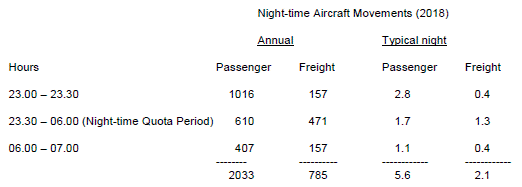
A detailed breakdown of the aircraft movement numbers by aircraft type are presented in
Appendix A.
For the Night-time Quota Count Period, the quota count sought for the calendar year amounts to
1995.
The above information forecasts that in 2018, an average of 7.7 flights per night will take place with
over 60% taking place during what are known as the shoulder periods of 23.00 -23.30 and 06.00 to
07.00 hours. It is generally accepted that the most sensitive time for people at night is the intervening
period and, from recent research, particularly during the hours of 01.00 to 06.00.
The conventional manner of assessing night-time noise however relies on the consideration primarily
of the overall night period from 23.00 to 07.00 and it is this 8 hour period that has been adopted,
together with the associated aircraft movement numbers, in the noise contours presented in this
report.
NIGHT NOISE ASSESSMENT CRITERIA
The assessment of airborne aircraft noise during the daytime is based entirely on LAeq,T dB contours.
Night-time aircraft noise is evaluated in different ways however, using different units, such as the
Single Event Level (SEL) as well as the LAeq,8h index (for the period 23.00 to 07.00 hours).
The technical matter of the effect of aircraft noise on sleep has been addressed on a number of
occasions by the CAA on behalf of the Department for Transport, and more recently in the work of
the Environmental Research and Consultancy Department, Directorate of Airspace Policy of the Civil
Aviation Authority. From work of this type, guidance on the appropriate method of noise-impact
assessment for the night-time period has been developed. Research studies into the field of the
effects of aircraft noise at night are on-going but the general methodology remains much the same
as has been in place for a number of years. The current guidance is underpinned by the
considerable research study undertaken by the Department of Transport and published in 19921 on
the topic of aircraft noise and sleep disturbance.
This extensive Department of Transport research study on the effect of night noise indicated that
outdoor noise levels below 90 dB(A) SEL due to aircraft noise events are most unlikely to cause any
measurable increase in the overall rates of sleep disturbance experienced during normal sleep. At
higher levels the study indicated that there was a 1 in 75 chance of the average person being
"wakened". One of the conclusions of the study was that, once asleep, very few people living near
airports are at risk of any sleep disturbance due to aircraft noise.
An interpretation of the research study results is that there is no significant risk of sleep disturbance
for locations outside 90 dB(A) SEL footprint area. For locations within 90 dB(A) SEL footprint, a very
slight risk of sleep disturbance will be present. The chance of "awakening" (1 in 75) relates not to
aircraft noise levels at 90 dB(A) SEL, but to aircraft noise levels in the range 90-100 dB(A) SEL.
Night-time noise from aircraft has also been considered taking into account the combined effect of
several aircraft at night, by determining the night-time LAeq,8h dB values. The use of A-weighted Leq
contours at night has been adopted in light of the findings of CAA research studies2 into night noise,
WHO guidelines and Planning Policy Guidance PPG 24 Planning and Noise which requires the
night-time LAeq,T dB value to be determined when assessing the suitability of a site for new housing.
The DoT study regarding sleep disturbance presented most of its conclusions in terms of the 90 dB
SEL value, as mentioned earlier in this section. The study did however also include information on
the measured sleep disturbance at the eight study sites in terms of the percentage arousals, and
separately the night-time combined aircraft noise level in terms of LAeq,8h. The sleep disturbance
information gives the percentage of sleep arousals at each site during periods which had an aircraft
noise event (noise epochs) and also during periods where no aircraft noise was present (quiet
epochs). The findings of the study are presented in Table 1 below.
1 Report of a Field Study of Aircraft Noise and Sleep Disturbance. Department of Transport, Dec 1992, Ollerhead J B et al
(1992).
2 DORA report 8008. Aircraft noise and sleep disturbance: final report. (1980). Prepared by the Civil Aviation Authority, on
behalf of the Department for Trade.
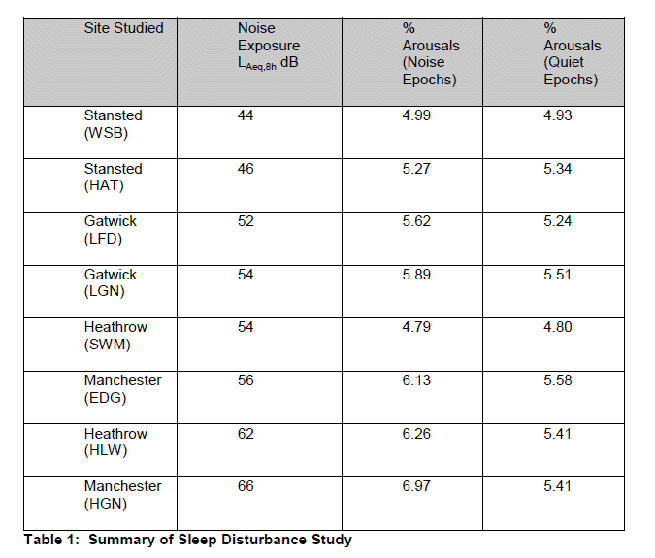
The information above indicates that the average noise exposure at the study sites varied from 44
dB LAeq,8h to 66 dB Laeq,8h.
To assess when the level of aircraft noise becomes significant with regard to sleep disturbance, the
two columns of percentage arousals have to be inspected. An increase less than 1% in percentage
arousals occurs when the noise exposure levels are 62 dB LAeq,8h. The increase becomes 1.5%
when the exposure reaches 66 dB LAeq,8h. This suggests a significant effect on sleep disturbance
when such levels occur. The early 1980's CAA studies into night noise advised on the LAeq unit
being a good aircraft noise disturbance measure for evening and night, and that there was a
discernible increase in disturbance when night-time noise exposure is about 65 Leq.
At lower levels, the increase in percentage arousals between quiet and noisy conditions is less clear.
The results are inconsistent at 54 dB LAeq,8h. At 56 dB LAeq,8h there is a very small increase (0.5%),
equivalent to two arousals per year.
Therefore, to ensure cautious impact assessment for the local community around Manston, a nighttime
criterion of 55 dB LAeq,8h has been used. This criterion level indicates when no consistent sleep
disturbance effect is found due to aircraft noise; i.e. below the level where a clearly discernible effect
has been established.
PPG 24 makes clear that use of the noise exposure category standards (for new residential planning
applications) cannot be made in the context of proposals which would introduce new noise sources
into areas of existing residential development and gives no guidance with regard to noise at night
from developments such as aerodromes. It does, however, report that Central Government
proposed in 1990 to adopt as a trigger level 57 dB LAeq,8h at Stansted Airport for sound proofing
eligibility at night.
The Government's policies with regard to planning and noise of new residential developments are
set out in Annex 1 of the PPG 24 document. 48 dB LAeq,8h has been taken to represent the level of
night-time noise where, although new dwellings may be constructed, noise should be taken into
account. Up to a level of 57 dB LAeq,8h, it states that noise should be taken into account and, where
appropriate, conditions imposed to ensure an adequate level of protection against noise. When the
noise level at night exceeds 57 dB LAeq,8h Government's advice is that planning permission should
not normally be granted. Where it is considered that permission should be given, conditions should
be imposed to ensure a commensurate level of protection against noise.
A summary of the PPG 24 guidance and other research findings is given in Table 6.7 below.
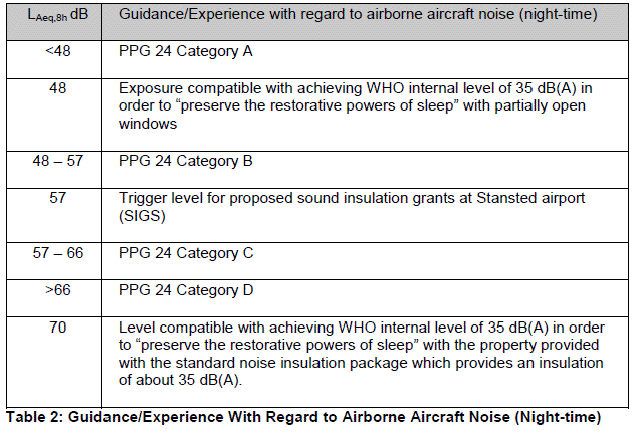
For some UK airports, dwellings are exposed to noise levels in excess of 60 dB LAeq,16h at night, eg.
Nottingham East Midlands Airport (over 200 dwellings ?60 dB LAeq,8h (in 2004)).
At lower levels, i.e. 55 dB LAeq,8h, the number of dwellings so exposed around some UK airports are
as follows:-
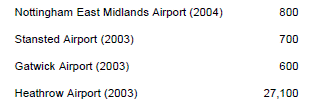
Annex 1 of PPG 24 also mentions a LAmax dB criterion for night-time noise levels with regard to
residential development sites, expressed as individual noise events regularly exceeding 82 dB LAmax
(S weighting) several times in any hour. Any site which is exposed to maximum noise levels of this
magnitude should be considered as Category C (unless the site is already in Category D). Detailed
research into aircraft noise at night has found that 82 dB LAmax is approximately equal to 90 dB(A)
SEL.
In the case of SEL values, PPG 24 above records that an individual event is required to occur
regularly above approximately 90 dB(A) several times in any hour to rate the site as Category C. This
demonstrates that the number of times a noisy event occurs is of relevance.
From studies undertaken by Griefahn and Scheuck3, evaluation criteria have been devised for
aircraft noise exposure to protect those living in the vicinity of civil airports. The criteria involve a
three tier hierarchy:
Critical limits -above these levels there is a risk of health effects and such levels should only be
tolerated as an exception for a limited time. Above these levels of noise it is imperative that noise
control measures should be introduced.
Protection Guides -Exposure below these levels should not induce adverse health effects in the
average person, although sensitive groups may still be affected. These are the `central assessment
values' above which action should be taken to reduce noise exposure.
Threshold Values -inform about measurable physiological and psychological reactions to noise
exposure where long term adverse health effects are not expected. To increase quality of life these
values constitute a long term goal.
The following limits are applicable for individual aircraft noise events over an 8 hour night period.

Taking account of the sound reduction that may be expected from outside to inside though a closed
single glazed window, which amounts to 27 dB(A) from PPG 24, this translates to the following:-

Based on the above night noise assessment review, in summary, the night-time aircraft noise at
Manston Airport may be assessed using two methods with their appropriate criteria:
3 Scheuch K, Griefahn B, Jansen G, Spreng M (2003). Evaluation criteria for aircraft
noise. Rev Environ Health, Jul-Sep 2003, 18(3), 185-201.
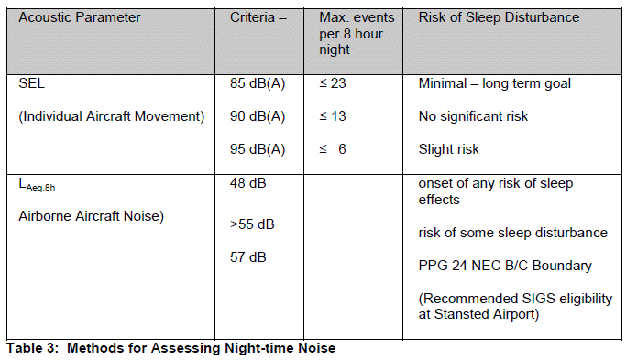
5.0 NOISE CONTOUR AND ASSESSMENT METHODOLOGY
5.1 General
The night noise contours and SEL footprints for Manston Airport have been generated using the
Integrated Noise Model (INM) developed by the Federal Aviation Authority. This software evaluates
aircraft noise in the vicinity of airports using flight track information, aircraft fleet mix, standard
defined aircraft profiles, user-defined aircraft profiles and terrain. It is commonly used to evaluate
noise around airports in the UK and worldwide.
Noise contours have been generated using the INM for the year 2018 which represents the date by
which the full usage of the night operations sought at Manston are expected to be achieved.
The assumptions upon which the noise contours presented in this report have been based are set
out in Appendix A. This includes description of a representative mix of the number of aircraft
movements expected in the future. Current activity levels at the airport at night lie below these levels
so any increase will occur gradually over a period of time.
The shape of the contours will be affected by the flight routes flown by the aircraft. Figure 1 illustrates
the departure and arrival routes in place at the airport and assumed in this analysis. For noise
abatement purposes, there is a preference for departing on Runway 10 although the wind direction
dictates to a large extent the runway usage. This analysis has assumed a runway usage of 67%
movements on runway 28 and 33% movements on runway 10 which is consistent with runway usage
throughout the 2009 calendar year.
SEL footprints have been generated for the most common aircraft types expected to operate at night
as follows:-
B737-800 most common passenger aircraft operating at night
B747-400 and MD 11 most common freight aircraft operating at night
6.0 IMPACT OF NIGHT-TIME AIRBORNE AIRCRAFT NOISE
6.1 Current Night Operations
Night-time aircraft movements at Manston currently occur on an ad-hoc basis and involve aircraft of
the type that are expected to fly in the future, for example the B747-400. The number of movements
that take place currently vary from week to week and month to month but are typically around 2 per
week at present. The night-time LAeq,8h contours for 2009 are presented in Figure 2.1.
There are currently no dwellings located inside the 48 dB LAeq,8h night-time noise contour, the area of
which is just under 1.0 km2.
The SEL footprints for freight aircraft in use today at MSE are discussed in Section 6.2 below.
6.2 Future Night Operations -2018
The night-time LAeq,8h dB contours for 2018 are presented in Figure 2.2 The 85, 90 and 95 dB(A) SEL
footprints for the most common aircraft operating at night are presented in Figures 3.1 to 5.2. The
SEL footprints relate primarily to operations on runway 28 as these impact people the most.
Footprints on runway 10 are however also presented for the B747-400, the most significant aircraft
concerning noise in 2018 operating at the airport.
The impact of night-time aircraft noise relates to the consideration of the noise contours, and noise
from individual aircraft movements. Table 4 gives details of the contour areas and estimates of the
number of dwellings situated within the LAeq,8h noise contour bands for the year 2018.
Dwelling counts and population numbers have been determined from a consideration of 2009
Census data by postcode location provided by CACI Ltd.
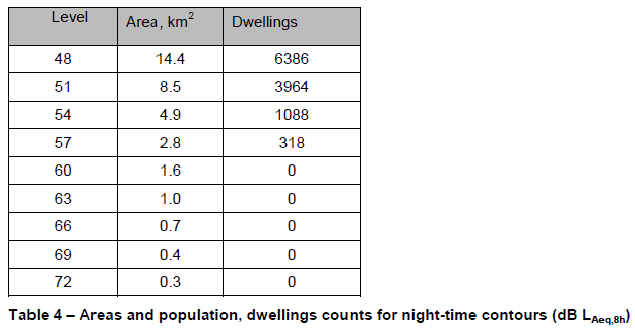
For freight aircraft, such as the B747-400, these are in operation today and are expected to remain
so in the future. Issues concerning noise from individual departures and arrivals are therefore equally
valid now as in the future. As discussed previously, the area under the 95 dB(A) SEL contour
indicates a slight risk of sleep disturbance provided the events are less than six per night. The
numbers of dwellings beneath the aircraft footprints are given in Table 5. Appendix A provides further
details of areas, dwelling and population counts for all SEL footprints.
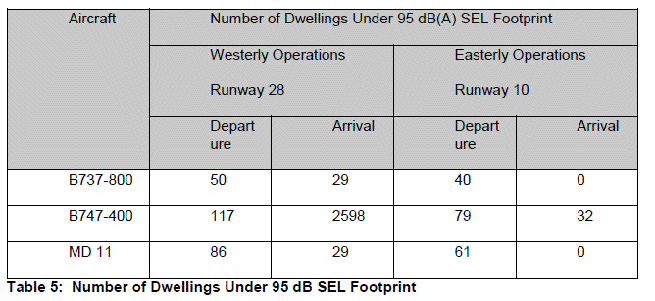
Table 4 indicates that 318 dwellings will be exposed to 57 dB LAeq,8h and above, whilst there are no
properties exposed to 60 dB LAeq,8h. An estimate of around 800 dwellings will lie inside the 55 dB
LAeq,8h criterion mentioned in Table 3 above, giving rise to a slight risk of sleep disturbance for some.
With respect to the noise effects of individual aircraft, Table 5 identifies that for all but the B747-400
aircraft, less than 100 properties lie within the 95 dB(A) SEL footprints for operations on either
runway. For the B747-400, an arrival over Ramsgate on runway 10 will expose over 2500 dwellings
to a noise level of 95 dB(A) SEL or greater. This one event however would only occur on average
around once every five nights throughout a year.
On average, there will be just under 8 individual aircraft movements per night operating at MSE by
2018, most of which will produce the smaller of the noise footprints described above. During each of
these aircraft events (excluding the B747-400), less than 100 dwellings will be exposed to a level of
95 dB(A) or higher although this would generally not occur more than around 4 times per night. For
those properties closest to the airport and receiving the highest noise levels however, some risk of
sleep disturbance will arise.
The computations of dwelling counts and contour areas assume flat terrain around the airport
whereas the western edge of Ramsgate Town lies at a lower ground level than the runway and
ground levels continue to fall towards the sea. It is estimated that this would reduce the noise levels
incident on properties beneath the flight path in this zone by around 0.5 to 1 dB as compared to
noise levels presented in this report.
The night traffic proposed in 2018 will however give rise to some risk of sleep disturbance to a
portion of residents in Ramsgate and also to some residents of isolated properties to the west of the
airport. The current situation is that these residents are exposed about once a week to high levels of
noise from ad-hoc freight movements into or out of the airport. This situation is likely to be of concern
to a few people but is generally considered acceptable and has been taking place for a number of
years. The numbers of these movements will gradually increase in the future towards the levels
forecast in 2018.
It would be appropriate to give consideration to the introduction of some measures to protect these
residents prior to night-time activity exposing dwellings to a certain level of noise. Given the small
number of individual aircraft events, it would not be appropriate to control aircraft noise by way of the
SEL unit. It is proposed to introduce a night noise quota count limit as part of the Night Flying Policy
and this will assist in limiting movements at night by the noisier aircraft types. The LAeq,8h unit would
be an appropriate means of introducing control since it takes account of the noise level and number
of movements that take place within a period.
It has been shown in this report that 55 dB LAeq,8h reflects the level at which there is some onset of a
risk of sleep disturbance whereas 57 dB LAeq,8h is the value suggested in PPG 24 for introducing
sound insulation to dwellings around Stansted Airport. Other UK airports operate sound insulation
schemes relating to night time traffic and operate similar schemes based on night-time contours in
the range 55 dB LAeq,8h (Robin Hood Doncaster Sheffield Airport) to 59 dB LAeq,8h (Liverpool John
Lennon Airport).
For Manston, in light of its relatively small size, it is suggested that consideration is given to
introducing a sound insulation scheme to protect dwellings exposed to 57 dB LAeq,8h at night. This is
consistent with guidance set out in PPG 24 and in line with what occurs at other UK airports.
With this measure in place, together with a suitable night noise quota count limit relating to the mix of
aircraft assumed in this report, the proposed night-time aircraft activities in 2018 at Manston Airport
are not expected to have any significant noise impact on the local community.
Peter Henson
Partner